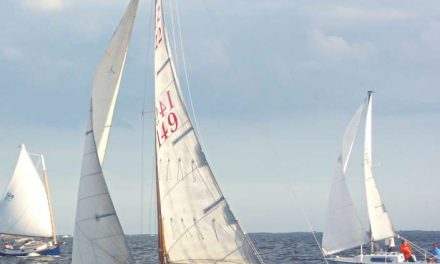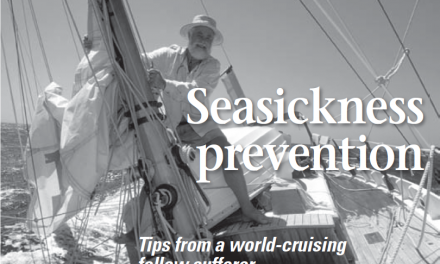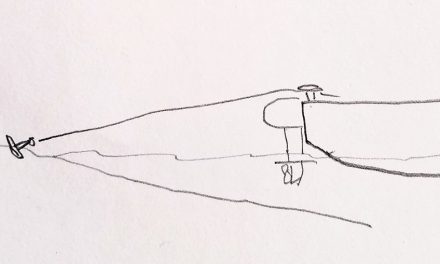Wherein a glorious small-boat adventure ends in ignominy and terror.
When I was young and thought I knew everything about boats and sailing, I would have laughed in your face if you had suggested that being towed was dangerous. I mean, come on—towing? Pulling one small boat behind another? What could be dangerous about that?
I was still quite young when I found out.
My education in this matter started when my librarian friend, Bob Stephen, came to see me in Madrid, Spain, where I was teaching conversational English. He had been reading a book by a British doctor who was exploring the French system of canals and waterways (Small Boat Through France, by Roger Pilkington.)
“Let’s go to England, buy a boat, and cruise the French canals,” said Bob.
“We could go through the European canals to the Baltic,” I said. “I hear there are naked blondes running through the woods in Sweden, chased by young men bearing birch branches.”
“Let’s do it,” said Bob. “But I need you because I don’t know how to sail.”
“And I need you because I’m broke. But if you buy the boat, I’ll sail her,” I promised.
And so, in England a few weeks later, Bob bought an ancient Thames Estuary One Design. She was a lapstrake open racing boat, an 18-foot centerboard dinghy that had been partially decked and provided with a small cuddy cabin just big enough to sleep two. She was sloop-rigged and equipped with a small and smoky British Seagull outboard motor. Her name was Salty Dog.
We sailed her across the busy English Channel, about 22 miles from Dover to Calais. After an uneventful passage, in Calais we lowered the mast, entered the vast French inland canal system, and motored north and east under a blue cloud of Seagull smoke.
People were so friendly to us along the way, and so insistent on showering us with hospitality, that after three months, we ran out of summer in Amsterdam. The Swedish nymphs would have to frolic in the woods without us. We had to turn back for home.
In Calais once more, we made ready for the return Channel crossing and waited impatiently for two days while a contrary gale blew itself out. On the afternoon of the third day, things had calmed down, and the British skipper of a 30-foot cabin cruiser moored ahead of us stopped by.
“Are you headed for Dover?” he asked.
“Yes, leaving on the evening tide.”
“Me, too. Not much wind for sailboats though. Would you like a tow?”
I smiled at our good fortune. “Very kind of you, so long as you don’t go too fast.”
He laughed, “Don’t worry, we just piddle along.”
So that afternoon, I sorted out a 75-foot length of nylon towline and made fast a kellet in the middle of it. I had read somewhere that a kellet—a heavy weight—would absorb slack in the towline and prevent snatching. It would smooth out the ride. You’re likely not picturing my kellet though, a handy-sized chunk of concrete with a loop of iron rod conveniently sticking out. I had found it on an adjacent building site.
We left Calais at sunset, towed by the powerboat. Just outside the harbor, the boat towing us slowed to a stop, and the skipper stepped into the cockpit to shout back to us, “Which way is Dover?”
I could hardly believe my ears. I gave him the course, which I had memorized, and he disappeared into the cabin where his three compatriots waited. He reappeared a couple of minutes later, again shouting back to us, “Can one of you come aboard and help us?”
Bob couldn’t be trusted to handle Salty Dog; he would have to go. We pulled alongside the cabin cruiser and Bob hopped aboard with our chart. I wondered about the value Bob offered; I knew he was not a navigator and had never steered a compass course.
We set off again in the darkness on what seemed to me to be roughly the right course. Then the nightmare began.
I heard a throaty roar from the twin engines of our towboat and felt a sudden acceleration. I clutched the tiller tightly as Salty Dog took a slight sheer and began to heel. I had lowered the heavy steel centerboard to add stability, but every time she wandered from her course by more than a couple of degrees, the centerboard would gain lift and she would heel to port or starboard. That meant quick corrective action at the tiller. It also meant I daren’t leave the tiller for a second. I was stuck. I couldn’t go below to raise the centerboard.
We were doing 10 knots by my estimate and the stupid kellet was skipping along the surface of the water and sending back great showers of spray every time it slammed into a wave. The spray landed in the cockpit, drenching me before draining directly into the bilge. The bow wave also sent spray flying aft. It, too, drained into the bilge after soaking me.
After a short while, and to my horror, I began to sense the uneasy roll of a boat that is starting to flood. By some good fortune, the bilge pump was fixed on the cockpit coaming, within reach of the helm. I started pumping.
As we tore along through the dark night, I wanted nothing more than to cast off the towline and get things back under control. But I couldn’t move to the bow where the line was made fast without causing the boat to nose-dive as the bilge water moved forward with me.
I screamed, “Slow down! Slow down!” until I was hoarse, but nobody heard me over the noise of the powerboat. I clung to the tiller and was dragged willy-nilly through the pitch-dark night, across the cold English Channel. I prayed we were at least going in the right direction.
After what seemed like half the night, we came upon a large ship at anchor. As we ran down its side, the skipper of our towboat shouted to a man on deck, “Where are we?” The man pointed down at the side of the ship. Six-foot tall white letters spelled out SOUTH GOODWIN. It was a lightship guarding the edge of the notorious Goodwin Sands.
“Which way to Dover?” asked the skipper. I cringed with shame and tried to look invisible.
“Over there, mate,” said the man, pointing to a cluster of lights on the horizon.
About half an hour later we reached the port of Dover. The motorboat towed us into the first darkened berth and made fast. With great relief I hauled Salty Dog up astern of the cabin cruiser. Almost instantly a gang of uniformed men surrounded us and ordered us not to move. Our motorboat skipper had towed us into a restricted berth, possibly a submarine pen.
We were interrogated individually. Salty Dog and the motorboat were searched from stem to stern. They tapped the base of our mast, as if looking for something hidden there, and slit open our two fenders. They even delved deep into my old navy kitbag, which held two weeks’ worth of sweaty old socks and used underwear.
It was some time after midnight when Bob and I were freed. I fired up the Seagull and we smoked our way around into the marina next door. The uniformed men were still fussing around the motorboat as we left.
We learned later that there had been a daring jewel heist in southern France. Interpol had alerted British ports. We wondered if it explained why four gormless non-sailors who had no idea how to navigate were trying to cross the Channel at night. But we never did hear what happened to the motorboat or its crew. We were only too glad to be rid of them. I hoped and prayed I would never be towed again.
The Takeaway
I was a lucky kid in this episode, doing what I could to survive—and I did survive. Now, with decades of wisdom gained through sailing and boating, I have a few common-sense rules that can lessen the risks of being towed, should you have to be towed.
- Especially if you are singlehanded, make sure you can cast off the towline from the helm position. To make this possible, lead the line through a fairlead at the bow or take a turn around a forestay or Samson post, and take the end back to a sturdy cleat in the steering cockpit. You may want to keep a sharp knife handy in case the line won’t come off the cleat for some reason.
- Don’t allow yourself to be towed at more than your hull speed. A displacement boat towed too fast will go down by the stern to the extent that the stern wave will curl over into the cockpit and probably sink the boat. If your towboat speeds up too much, simply slip your towline. This is knowledge that should be shared with the towboat operator before the tow begins.
- Raise your plate if you are a centerboarder.
- Work out some means of instant communication between the two boats. A handheld VHF radio in the towed boat should suffice, provided it doesn’t get swamped with spray and provided the towboat is listening on the same frequency. At night, a powerful flashlight might attract the attention of the towboat. Ideally, by day or night, someone on the towboat should be designated to keep a full-time watch on the towed boat.
- Being towed is a helpless feeling. You have no control over where you’re going or how fast. You have no way to control your direction, no way to ensure you don’t end up on a sandbank or on rocks. Be wary if the towboat draws much less than your boat. And be very careful about who tows you.
- Finally, make sure you’re not a salvage prize, or it could be the most expensive tow of your life.






